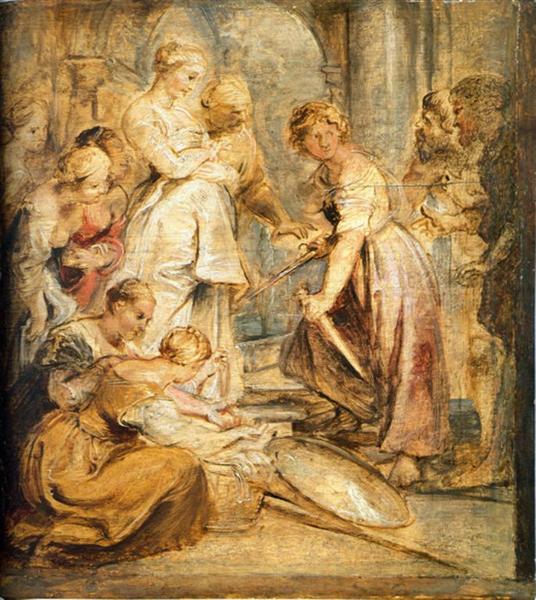Descrição
The painting “Achilles and the Daughters of Lykomedes,” painted by Peter Paul Rubens in 1617, is a work that encapsulates both the artist’s technical mastery and his ability to narrate through imagery. This painting is set in a mythological context that depicts an episode from the life of Achilles, the hero of the Trojan War. In this scene, Rubens delves into the theme of femininity and masculinity, presenting the daughters of Lykomedes, who, according to legend, hide Achilles to prevent him from joining the war effort.
At first glance, the work stands out for its dynamic composition, which is a hallmark of Rubens’ style. The arrangement of the characters creates a sense of movement, while their expressive poses lend a remarkable emotionality to the scene. Achilles, dressed in armour, stands in the centre of the painting, surrounded by the daughters of Lykomedes, who crowd around him. This conflict between duty and desire is palpable through the interaction of the characters. The women, with their expressive postures and gazes, seem at once attracted and tense, revealing the hero’s seduction and resistance to his fate.
The use of colour in this work is particularly significant. Rubens employs a rich, warm palette, with gold and brown tones evoking both the richness of the landscape and the warmth of human interaction. The skin tones of the daughters contrast with the coldness of the metal of Achilles' armour, thus underlining his vulnerability and humanity as opposed to his role as a warrior. Light and shadow play a fundamental role, directing attention towards Achilles and creating a dramatic atmosphere that is characteristic of the Baroque.
Besides its remarkable technique, another fascinating aspect of this painting is the depiction of the myth itself. Through this work, Rubens not only recreates a specific scene but also offers a visual interpretation of universal themes such as love, sacrifice and war. The tension between peaceful life, represented by the daughters of Lykomedes, and the inevitable call of conflict, symbolized by Achilles, resonates deeply with the viewer.
Although Rubens is often associated with depicting myths and classical themes, this work also reflects his interest in the psychology of his characters. The facial expressions and gestures that Rubens gives to each of Lykomedes' daughters display a range of thought-provoking emotions, from uneasiness to longing. This detailed focus on human expression is one of the reasons why Rubens is still considered one of the masters of Baroque art.
In conclusion, “Achilles and the Daughters of Lykomedes” is much more than a mere visual representation of a myth; it is a rich and complex exploration of human relationships and universal dilemmas. The fusion of Rubens’ exceptional techniques with a rich mythological narrative creates a work that not only captures the viewer’s attention, but also invites them to contemplate the nature of bonds, bravery, and inevitable fate. This painting, like many of Rubens’ masterpieces, remains a point of reference for artists and critics, highlighting the enduring relevance of its themes and its unmatched technical mastery.
KUADROS ©, a famous painting on your wall.
Hand-made oil painting reproductions, with the quality of professional artists and the distinctive seal of KUADROS ©.
Painting reproduction service with satisfaction guarantee. If you are not completely satisfied with the replica of your painting, we will refund 100% of your money.

